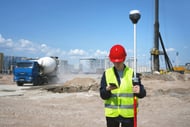Why it’s important to provide PPE for women
Employers must ensure than PPE for men and women fits correctly and is provided in equal measure.
James Rowland
Commercial Director James leads Account Management, Sales and Marketing at Neathouse Partners.Date
08 May 2024Updated
10 June 2024
Table of contents
Related articles
For many employers, and especially those in the construction or building industries, wearing personal protective equipment (PPE) is crucial. There are many types of PPE available on the market today, including PPE that is designed for women. However, according to the Considerate Constructors Scheme, 59.6% of employers do not provide women’s-specific PPE.
The organisation’s research also uncovered evidence that women were being provided with ill-fitting PPE, which affected both their personal safety and experience at work.
Employers should note that PPE must fit workers properly. Due to anatomical differences between men and women, women’s PPE will fit the body differently. In some industries, because they are more male-dominated, some companies take a one-size-fits-all approach to PPE.
Women account for less than 15% of the workforce in the construction industry, which can lead to employers treating women’s PPE as less of a requirement and more of a secondary thought.
In order to promote professionalism and to ensure personal safety, employers must ensure than PPE for men and women fits correctly and is provided in equal measure.
Ill-fitting PPE is a problem for workers
Whether it’s PPE or a corporate uniform, having good-fitting clothing is a sign of professionalism within an organisation. A professional image reflects well on a company and ties in with their values.
Ill fitting clothes and PPE isn’t a good reflection on an organisation, and can give the impression that a company doesn’t care about the wellbeing of its staff.
If a female member of staff wearing PPE looks uncomfortable, this might appear as a sloppy approach to safety. This message becomes compounded if male workers on the same site are wearing PPE that is a good fit.
What is PPE for women?
Personal Protective Equipment (PPE) is very important for ensuring workplace safety, especially when on a building or construction site or a place that uses technical equipment. It’s vital for employers to provide PPE that is tailored to women’s specific needs.
In the UK, the Personal Protective Equipment at Work (Amendment) Regulations 2022 state legal requirements that employers must follow for PPE provision. For women, this means being provided with effective PPE such as high-vis clothing, safety glasses, gloves and protective footwear designed with both safety and comfort in mind. Earplugs or muffs are essential to protect hearing from excess noise, and hard hats ensure head safety.
Respirators should be used to protect against airborne hazards, while high-visibility overalls, vests and full-body suits offer comprehensive protection against various risks. Employers are legally required to provide appropriately fitting PPE, considering factors such as size, flexibility and breathability to ensure that workers stay comfortable when wearing the PPE for extended hours.
Addressing the unique requirements of women when it comes to PPE not only ensures compliance with legislation, but also fosters a safer and more inclusive working environment.
Female PPE is specially designed for the build of a woman’s body, with different fittings in the chest and waist to give a better comfort and fit. Some garments could be made from a stretched fabric or could be more elasticated to give the material more flexibility and a more tailored fit. As every woman has a different body shape and build, this can be important in obtaining a comfortable size.
Providing female workers with men’s PPE in smaller sizes isn’t a solution, and can minimise protection. Employers must understand that workers who are not comfortable in what they are wearing, or who feel embarrassed in poor-fitting PPE will have a lower morale and could be less likely to remain in their job. They may even feel discriminated against, especially in the case of pregnant women if an employer hasn’t made an effort to provide PPE that caters to their requirements.
Differences between workwear and PPE
There are considerable differences between PPE and typical workwear. PPE gives workers hazard-specific protection from environmental factors such as chemicals, heat, noise or impact, with materials and features that are designed to give the body effective protection.
PPE is mandated by health and safety regulations in the UK, and employers are legally obliged to provide suitable PPE to employees who are exposed to hazards. PPE includes specialist equipment such as safety glasses, gloves, helmets, marks, respirators and hearing protectors, and is usually worn over regular workwear, so that the wearer still has comfort and functionality.
Typical workwear on the other hand includes typical clothing items, such as uniforms and overalls, or casual/formal attire like shirts and trousers. If workers aren’t able to wear their own clothing in their roles, a uniform is another example of typical workwear that may feature branding.
Facts on poorly fitting PPE for women
In June 2023, a LinkedIn Group known as Bold as Brass, which provides support for women in construction industries, claimed that in one of its surveys of 130 women, 80% of respondents had been given ill-fitting PPE at work by their employers. This led to 32% of women feeling unsafe in their working environment due to poorly fitting clothing. 5% of women had even claimed that they couldn’t work because the PPE they needed wasn’t available in their size when they got to their work site.
Unfortunately, the majority of PPE is still designed to fit the average man’s body. Some PPE marketed at women can also be pink in colour, but still cut to fit a man’s body.
According to the National Association of Women in Construction (NAWIC), increasing numbers of women over the years have suffered from workplace injuries because of being forced to wear oversized PPE. Women construction workers wearing overly large gloves risk having them pulled into machinery, or having eye or skin injuries because of having to wear glasses or masks that aren’t designed to fit a woman’s face.
The National Association of Women in Construction Yorkshire is currently working with 14 construction frameworks on a campaign to make PPE equipment more readily available to female construction workers, encouraging employers to provide a more inclusive working environment.
What should an employer do if a worker refuses to wear PPE?
As an employer, it’s your legal responsibility to provide a worker with PPE. If a worker refuses to wear Personal Protective Equipment (PPE), you’ll need to step in and communicate effectively to address the worker’s concerns so that you can ensure their safety and the safety of their colleagues.
Communicate openly with the worker to understand the reason behind their refusal (they might be refusing to wear PPE because of religious or health grounds). Remind them of the importance of PPE in ensuring their safety and the safety of others in the workplace.
Provide comprehensive training on the purpose, proper use and benefits of the specific PPE required for their job. Ensure that they understand the risks associated with not wearing PPE, and the potential consequences for not wearing it.
If a refusal to wear PPE is based on religious or health grounds, you should look at ways to accommodate this while still maintaining adequate protection. Our team of experts at Neathouse Partners can guide you on this if you are unsure. Work with the employee to find alternative PPE options, without compromising health and safety.
If there are any underlying issues related to poor management that may have caused the refusal to wear the PPE, take steps to improve communication, provide clear instructions, and take disciplinary action if required. Clearly outline the consequences of non-compliance while also giving support and resources. Involve workers in the decision-making process when it comes to sourcing and providing PPE. Ask them what they need from you.
Ensure that you keep written records of discussions, training sessions and accommodations, and any corrective actions that have been taken if a worker refuses to wear PPE. This will mean that you have a reference for future if needed.
We can advise on PPE and safety-related issues
All employers should provide appropriate PPE. If a worker has refused to wear PPE, or you need advice on providing PPE accommodations for your workers, get in touch.
Our team of professionals at Neathouse Partners can advise on how to exercise your legal duty of care, and help you navigate difficult conversations while providing the right equipment. Get in touch today >
Related blog posts
Advances In PPE & The Responsibilities Of An Employer To Consider
Safety in Construction: A Snapshot for Employers
How To Be A Family Friendly Employer
Creating a sun safe workplace
Have questions?
Get in touch today
Contact us, and our team will get back to you within 24 hours. We value your questions and are committed to getting them answered quickly.


Hello! I am Nicky
Just fill in the form below with your details, and I will arrange for a member of our team to give you a call.
By clicking, you agree to our Privacy Policy



